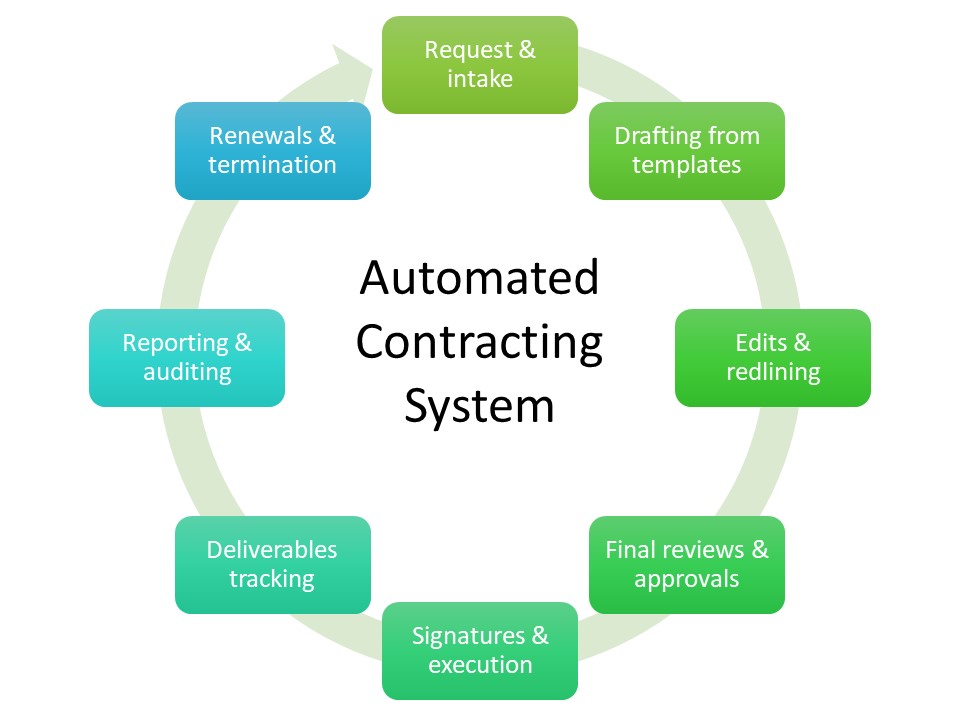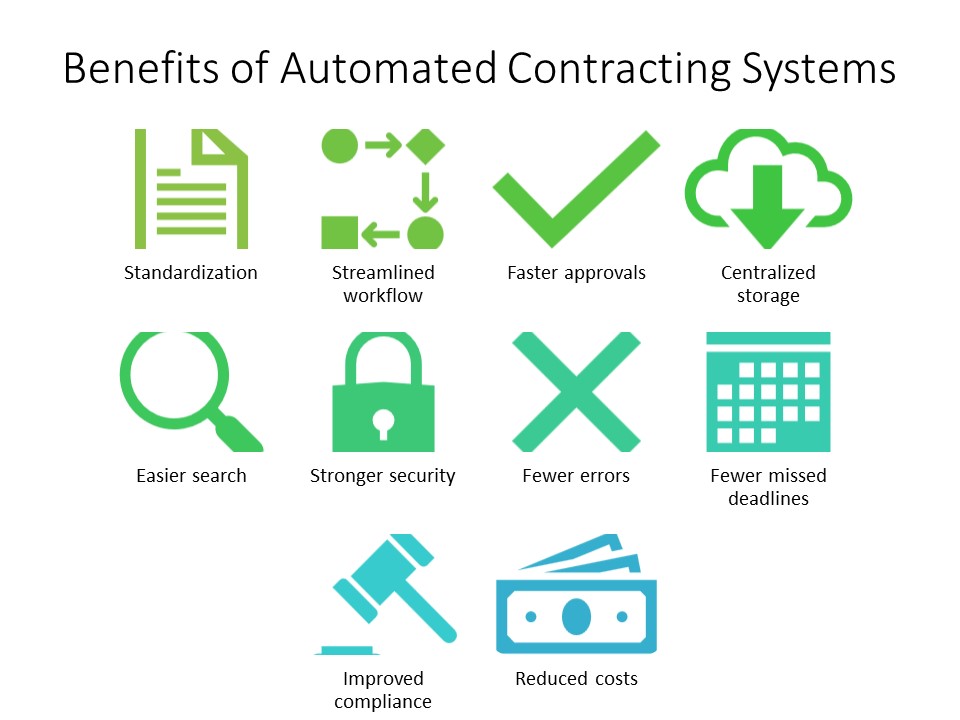10 Things an Automated Contracting System Can Do for You
Do you know the key benefits of an automated contracting system? You miss out on several important benefits if you’re still managing your contracts manually. Moving to an automated contracting system can save you time and money, mitigate risk —and make the entire contracting process much easier to manage.
Key Takeaways
- An automated contracting system automates the entire contract workflow, from inception to archiving
- An automated contracting system provides standardization, a streamlined workflow, faster approvals, and fewer errors
- You also get centralized digital storage, easier contract searching, stronger security, and improved compliance
- Automating your contract process results in fewer errors and reduced costs
What Does an Automated Contracting System Do?
Every organization has to deal with contracts. Whether you’re buying a product or service from another company or selling your products and services to customers, contracts are essential for your business operations.
Before contract automation via contract management software, the entire contract workflow was handled manually. Individuals in different departments would author new contracts from scratch, email around the drafts throughout the company for review and approvals, go back and forth with edits and changes, and then track down the principals who needed to sign each contract. After execution, contracts were filed away in shared drives, personal hard drives, or even massive file cabinets filled to the brim with paperwork. It is a slow, messy, and expensive process. In fact, many organizations still manage contracts using antiquated methods just like that involving endless emails, Excel sheets, and SharePoint or Box to store the documents.

Today, however, automated contracting systems streamline the entire contract process. Everything is digital, from inception to archive, so there’s no more paperwork, spreadsheets, or shared drives involved. Digital contracts flow electronically from department to department in an automated workflow process. They are stored in a central digital database for easy retrieval and auditing. Nothing is left to chance, and everything is done more quickly and more accurately.
The best automated contracting systems, such as ContractLogix’s Contract Lifecycle Management (CLM) system, improve efficiency, reduce costs, mitigate risk, and dramatically speed up the entire contract workflow.
Ten Benefits of Using an Automated Contracting System
There are numerous benefits your organization can realize from switching to an automated contracting system. Here are 10 of the most significant.

1. Standardized Terms and Language
Most automated contracting systems support a library of predesigned contract templates. Instead of writing each new contract from staff, with the attendant inconsistencies and inaccuracies, each new contract is based on your contract templates that uses standardized language approved by all the key parties in your organization such as Legal. By using pre-approved terms and clauses in the library, you eliminate the possibility of rogue employees cutting unauthorized deals. It simplifies contract creation and standardizes all your contracts going forward.
2. Streamlined Workflow
One of the most significant benefits of using an automated contracting system is that it streamlines and automates your contract workflow, reducing the time from initial contract requests to final approval and execution. You get contracts approved faster and in accordance with your business rules and regulations, which speeds up other processes and operations and improves compliance in your organization.
Streamlining the contract workflow also improves your staff’s efficiency. Team members spend less time walking contracts from one department to another and on menial tasks, which frees up more time to spend on more productive activities. Your staff gets to work smarter and faster, which benefits all involved.
3. Faster and Easier Approvals
Automating the contract workflow makes it easier to get contract approvals. Contracts are automatically routed to the right individuals electronically, with no guessing as to who should see the contract next and how to get it to them. Routing is instantaneous, and reviews are easily accomplished. You minimize the amount of routing back and forth and ensure that contracts never go to the wrong individuals for approval. This speeds up the entire approval process and again, helps ensure compliance with your business rules and processes.
4. Centralized Digital Storage
One key component of an automated contracting system is the centralized digital contract repository. All contracts are created in digital format and flow digitally through the system. Upon execution, contracts and all supporting documents are stored in a central database. Centralizing all contract storage has numerous benefits in and of itself, including:
- Eliminates wasteful data silos
- Makes all contract information available for reporting and analysis
- Ensures contracts don’t get misplaced or lost
- Eases the audit process
- Improves security
- Enables access to contracts from anywhere and any device type
5. Easier Search and Retrieval
Data in the 2021 Ernst & Young Law Survey reveals that 90% of legal professionals have trouble locating individual contracts. That issue is minimized when you use an automated contracting system.
Centralizing all contracts digitally makes it easier to search for, retrieve, and update old contacts. Contracts are all digitized, indexed, and supported by detailed metadata for each file. This improves accessibility; individual contracts or specific contract data can be found with a simple keyword search. In addition, you can view information by any relationship such as contract, contact, organization, document, and more.
6. Stronger Security
Another benefit of storing contracts in a central digital repository is that it makes your contracts easier to secure than if they were stored in multiple individual databases or, for paper contracts, physically stored in filing cabinets. A central repository provides a single point to secure with all state-of-the-art cybersecurity tools. Security is enhanced by limiting access only to those individuals with a demonstrated need to view or edit specific contracts.
7. Fewer Errors
Manual contract management is rife with errors only because error-prone human beings handle all contracts. Automating the process reduces the opportunity for human error, improving contract accuracy. Your contracts will be more reliable, as will the contract workflow as a whole. And, personnel no longer need to manually enter information in multiple places.
8. Fewer Missed Deadlines
With manual contract management, it’s easy to miss important deadlines and deliverables such as an upcoming autorenewal. Contracts get misfiled, or key information doesn’t get transmitted to the proper individuals or departments, and you end up not knowing when something is due.
That’s not the case with an automated system. All deadlines are automatically entered into the electronic system, and alerts are automatically sent prior to all contracted deadlines. Contract line items can be tracked automatically, and you can opt to be notified when the other parties are late with their deliverables.
In addition, an automated contracting system does a much better job alerting you when a contract is due to expire. You’ll get a heads-up so you can renew or renegotiate key contracts. No old contracts will expire without notice.
9. Improved Compliance
More than half (57%) of senior-level executives say regulatory compliance is one of the top priorities for their companies. Fortunately, automated contracting systems reduce the risk of non-compliance.
Because all contracts are built from legally preapproved templates, you’re assured that all new contracts fully comply with all applicable government or industry regulations. You no longer run the risk of a rogue contract inadvertently putting your organization at risk of non-compliance just because a given individual wasn’t aware of a specific regulation. In addition, automated workflows ensure business and regulatory processes are always followed and tracked with a complete audit trail.
10. Reduced Costs
One of the most significant benefits of using an automated contracting system is that it helps to reduce costs. In particular, automating various formerly manual processes can dramatically reduce administrative expenses. In addition, by ensuring that you don’t miss deadlines, you reduce potential late payment or noncompliance fees. Finally, you save money by reducing the number of errors in your contracts. It’s a financial win-win across the board.
Let Contract Logix Automate Your Contracting Process
When you want to improve contract workflow and efficiency, turn to the experts at Contract Logix. Our cloud-based CLM Platform automates the entire contract process, from initiation and creation to execution and archiving. Our CLM software helps you manage all your contracts, keep track of all deliverables, and ensure that your contracts comply with your company’s standards and industry regulations. You’ll save time and money while reducing errors and risks.
Contact Contract Logix today to learn more about automated contracting systems.
Read another recent article from our team, Contract Strategy for Successful Project Management: 8 Tips


